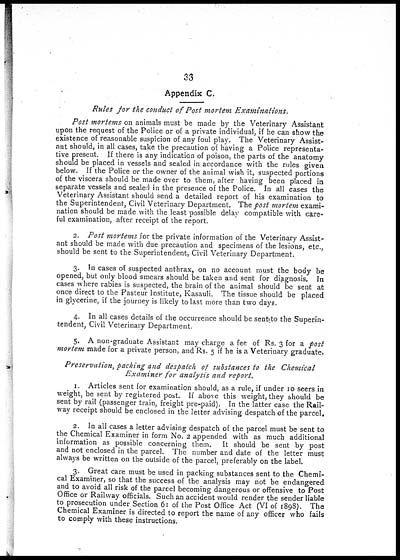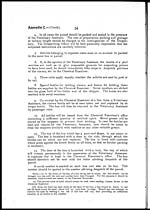Medicine - Veterinary > Civil Veterinary Departments > Manual of the Civil Veterinary Department, Central Provinces and Berar > Manual of the Civil Veterinary Department, Central Provinces
(41) Page 33
Download files
Individual page:
Thumbnail gallery: Grid view | List view

33
Appendix C.
Rules for the conduct of Post mortem Examinations.
Post mortems on animals must be made by the Veterinary Assistant
upon the request of the Police or of a private individual, if he can show the
existence of reasonable suspicion of any foul play. The Veterinary Assist-
ant should, in all cases, take the precaution of having a Police representa-
tive present. If there is any indication of poison, the parts of the anatomy
should be placed in vessels and sealed in accordance with the rules given
below. If the Police or the owner of the animal wish it, suspected portions
of the viscera should be made over to them, after having been placed in
separate vessels and sealed in the presence of the Police. In all cases the
Veterinary Assistant should send a detailed report of his examination to
the Superintendent, Civil Veterinary Department. The post mortem exami-
nation should be made with the least possible delay compatible with care-
ful examination, after receipt of the report.
2. Post mortems for the private information of the Veterinary Assist-
ant should be made with due precaution and specimens of the lesions, etc.,
should be sent to the Superintendent, Civil Veterinary Department.
3. In cases of suspected anthrax, on no account must the body be
opened, but only blood smears should be taken and sent for diagnosis. In
cases where rabies is suspected, the brain of the animal should be sent at
once direct to the Pasteur Institute, Kasauli. The tissue should be placed
in glycerine, if the journey is likely to last more than two days.
4. In all cases details of the occurrence should be sent to the Superin-
tendent, Civil Veterinary Department.
5. A non-graduate Assistant may charge a fee of Rs. 3 for a post
mortem made for a private person, and Rs. 5 if he is a Veterinary graduate.
Preservation, packing and despatch of substances to the Chemical
Examiner for analysis and report.
1. Articles sent for examination should, as a rule, if under 10 seers in
weight, be sent by registered post. If above this weight, they should be
sent by rail (passenger train, freight pre-paid). In the latter case the Rail-
way receipt should be enclosed in the letter advising despatch of the parcel,
2. In all cases a letter advising despatch of the parcel must be sent to
the Chemical Examiner in form No. 2 appended with as much additional
information as possible concerning them. It should be sent by post
and not enclosed in the parcel. The number and date of the letter must
always be written on the outside of the parcel, preferably on the label.
3. Great care must be used in packing substances sent to the Chemi-
cal Examiner, so that the success of the analysis may not be endangered
and to avoid all risk of the parcel becoming dangerous or offensive to Post
Office or Railway officials. Such an accident would render the sender liable
to prosecution under Section 61 of the Post Office Act (VI of 1898). The
Chemical Examiner is directed to report the name of any officer who fails
to comply with these instructions.
Set display mode to: Large image | Zoom image | Transcription
Images and transcriptions on this page, including medium image downloads, may be used under the Creative Commons Attribution 4.0 International Licence unless otherwise stated. ![]()
| Permanent URL | https://digital.nls.uk/75692408 |
|---|




